Stalking The Canada Goose
Reprinted from "The Nfld Sportsman" (Sept.-Oct.98) (Copyright © 1998 David Tilley)
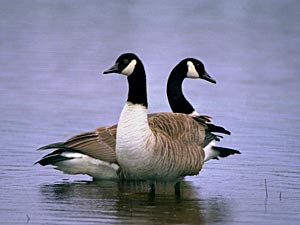 In a world of constant change it would be nice to believe that some things are truly constant and will never change. Once you've discovered that some of the best things about this world are free and available you would like to hang on to them as long as you live. So it is with my seasonal trips to the barrens to witness the life cycle of Canada Geese. Atlantic Canada Geese are native to Nfld. and have always returned every spring at the first sign of breakup to repopulate their family breeding ponds. It is a welcome sign of spring when the loud raucous calls of breeding Geese echo throughout the still air on a damp drizzly day in the barren country. Breeding geese are territorially aggressive and routinely return to the same areas to breed year after year. The family unit having migrated south in the late fall return together with the yearling birds breaking off into a separate flock, often feeding nearby while the parents begin another season.
In a world of constant change it would be nice to believe that some things are truly constant and will never change. Once you've discovered that some of the best things about this world are free and available you would like to hang on to them as long as you live. So it is with my seasonal trips to the barrens to witness the life cycle of Canada Geese. Atlantic Canada Geese are native to Nfld. and have always returned every spring at the first sign of breakup to repopulate their family breeding ponds. It is a welcome sign of spring when the loud raucous calls of breeding Geese echo throughout the still air on a damp drizzly day in the barren country. Breeding geese are territorially aggressive and routinely return to the same areas to breed year after year. The family unit having migrated south in the late fall return together with the yearling birds breaking off into a separate flock, often feeding nearby while the parents begin another season.
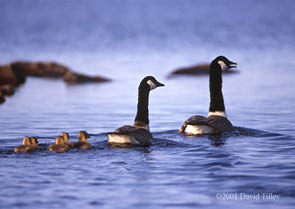
Following the sounds of geese honking in the spring will lead you to witness the fierce wild nature of these birds as they forcibly drive other mating pairs out of their territories by hurling their bodies with beaks outstretched in harpoon like fashion. I'm sure that this display is more of an attempt to intimidate than an actual attack since the challengers are likely to be close cousins having been born in the same place. As the daylight fades a human intruder can be mistaken for a long necked challenger and be chased after in defence of territory. I have had to go well out of my way to avoid them when the light was too low for photography only to end up sitting in a clump of brush with a saucy pair of loud honkers attempting to ferret out the reluctant challenger.
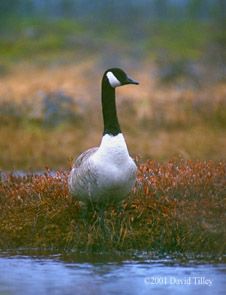 The noisy nesting behaviour of Canada Geese is meant to establish and defend territory and will end abruptly when 5 or 6 goslings hatch. Most of the time while the goose is on the nest the gander will float offshore acting as a sentinel, while a circling gull watches for a chance to vandalize a temporarily abandoned clutch. Occasional bouts of honking and winging from puddle to puddle reinforces the bonding and territorial rites of mated pairs. After about 26 days of nesting I can return to the area to see the young goslings being escorted around the pond feeding along the shoreline with the nest as a focal point. After a few days the family group will start a long trek cross country and are likely to disappear without notice. The ribbed fens of the interior make excellent stopovers as the procession continues to march ahead growing in leaps and bounds as they learn the local geography. This is probably the most critical time for young geese since an intruder forcing the parents to flee to a safer vantage point will find them sitting along the waters edge with only a few blades of grass for concealment. If there is enough warning, the gander will usually attempt to lure away an intruder with vocalizations while the goose scurries off in the opposite direction with her youngsters underfoot.
The noisy nesting behaviour of Canada Geese is meant to establish and defend territory and will end abruptly when 5 or 6 goslings hatch. Most of the time while the goose is on the nest the gander will float offshore acting as a sentinel, while a circling gull watches for a chance to vandalize a temporarily abandoned clutch. Occasional bouts of honking and winging from puddle to puddle reinforces the bonding and territorial rites of mated pairs. After about 26 days of nesting I can return to the area to see the young goslings being escorted around the pond feeding along the shoreline with the nest as a focal point. After a few days the family group will start a long trek cross country and are likely to disappear without notice. The ribbed fens of the interior make excellent stopovers as the procession continues to march ahead growing in leaps and bounds as they learn the local geography. This is probably the most critical time for young geese since an intruder forcing the parents to flee to a safer vantage point will find them sitting along the waters edge with only a few blades of grass for concealment. If there is enough warning, the gander will usually attempt to lure away an intruder with vocalizations while the goose scurries off in the opposite direction with her youngsters underfoot.
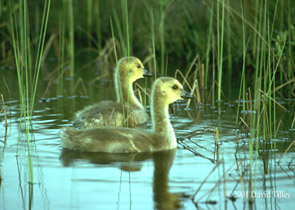 As the adults moult they become flightless for a short period and also have nothing more than camouflage and a cool nerve as protection. A goose that had the misfortune to honk late one evening in July was found later frozen to a boulder and was completely motionless for the whole while as I examined it up close. I seriously doubt if it would have been persuaded to part with a feather though, with water nearby it was keeping its options open.
As the adults moult they become flightless for a short period and also have nothing more than camouflage and a cool nerve as protection. A goose that had the misfortune to honk late one evening in July was found later frozen to a boulder and was completely motionless for the whole while as I examined it up close. I seriously doubt if it would have been persuaded to part with a feather though, with water nearby it was keeping its options open.
The period of laying low continues until mid August on the island when a mature flock takes to the air. Larger ponds and lakes offer the best protection until that time because of the possibility of escape to open water from the grass lined shores where the feeding family may be surprised by a four legged stalker. The young goslings are excellent swimmers and can even dive for short distances. This liking for water probably comes from an acquired taste for the tender roots that grow beneath the surface. Mature geese can easily float upside down with webbed feet extended and long necks poking at bottom weeds for extended periods. A truly puzzling sight to the first time witness.
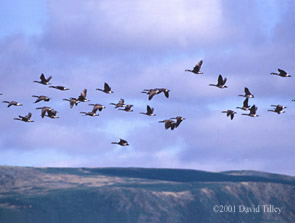 The fledged flocks are often joined by at least one other family unit as mating rivals become cooperative cousins once again. This is one of the better times to see geese as they follow a ageless circuit of rounding feeding ponds predictably from year to year. As the summer cools and the air becomes clear at sunset the feathers of these birds aloft can turn to solid gold in the reflected light. It is these images and the knowledge that they will be repeated with every passing season that brings me back year after year to this refuge from a reckless crazy world.
The fledged flocks are often joined by at least one other family unit as mating rivals become cooperative cousins once again. This is one of the better times to see geese as they follow a ageless circuit of rounding feeding ponds predictably from year to year. As the summer cools and the air becomes clear at sunset the feathers of these birds aloft can turn to solid gold in the reflected light. It is these images and the knowledge that they will be repeated with every passing season that brings me back year after year to this refuge from a reckless crazy world.
Geese are well accustomed to hunters and are careful to drop out of sight the day before open season. As the bogs begin to freeze in late fall larger flocks will be found standing on the ice in their tiny breeding ponds as the south migration begins. I have always used the appearance of geese as they develop through their annual cycle to mark the changing of the seasons. While the human biological clock suffers from technological jet lag these world travellers are synchronized with a true universal constant that tells them how and when to navigate from generation to generation. Learning about our wild cousins and the world that they belong to can reset our own clocks to a world created for the experience of living rather than profit.
It's more then just the thrill of the hunt, the stories of adventure and meat for the table. It is being born with an opportunity to relish the lifelong experience of celebrating our national treasure. The wilderness and wildlife resource of which the Atlantic Canada Goose is our proudest symbol.
